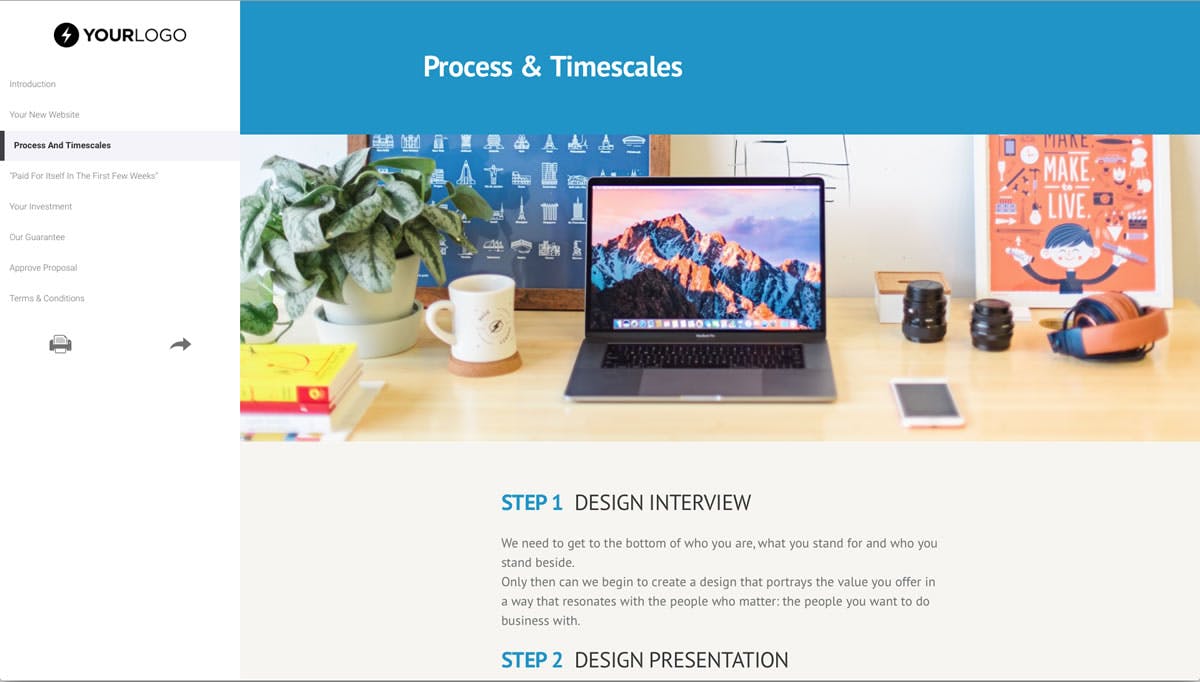As a developer, you probably feel pretty confident about your knowledge and the ability to write some code.
However, when it comes to business and the art of selling, very few developers know how to get the rates they deserve.
Much of this is because you don’t do well in one of the most important parts of the sales process – your business proposal.
Here are a few tips on how to create a great web development business proposal.
Use templates
If you pitch a lot of clients, you’ll soon realize that writing proposals manually from scratch takes too much time and effort. Instead, create one good web development proposal template where you can edit out the main data points. That way, you can finish a proposal in 30 minutes instead of several hours.
The best way to go about this is to create one ideal proposal. Take your time to get all the elements right – the introduction, the detailed specification, timescales, the design… Once this is done, save it as a template and base your future proposals on this template. Alternatively, you can use proposal management software such as Better Proposals to take care of this – you can shave hours off your proposal writing.
Write a kick-ass introduction
Your client already knows that you do web development and that you want to create a website, app or something else for them. The introduction is the place where you state this information, show what you do and state how you solve the client’s problem. Use simple language and don’t resort to the language you’d use with another developer or project manager.
The introduction is one of the two places where the client will spend the most time on your proposal, so make sure to spend enough time here yourself. My top tip would be to mimic the client’s language and talk back to them – explain in similar words how you will help them. To do this efficiently, it’s great to have a discovery session or meeting before writing the proposal.
Write a detailed specification
This is the time to get into the details of how your development project will solve the client’s pain point. It’s a great place to mention details such as:
- How many developers will be working on the project
- Which language they will be using
- Which methodology you will use (Agile, Scrum, etc.)
- Which other stakeholders will be involved (designers, QAs, project managers…)
Besides letting the client know that you’re a professional, think of this section as a liability – in case something goes wrong, both you and the client can refer to it.
The timescales
The most important detail of them all gets a separate section. In this part of the proposal, state exactly when you’ll be able to finish with the project. If you know that the client has some special event going on (a new project launch, expected app launch, MVP launch, etc.), use this information and make sure to state the deadline before this date.

The proof
The only way the client can be certain that you can do the job you’re offering to do is by showing them examples of work you’ve done before. In this section, list a few examples similar to what you’re expected to do for the client. Don’t just send your portfolio or paste a list of random links – showcase those projects that are most similar to theirs.
The pricing
The second most viewed section of all proposals, pricing needs your complete attention. The first tip I have is to be considerate with the name – instead of pricing, try naming it ROI, return on investment or simply investment. It makes a surprising difference in conversions.
The second tip I have is to have a single pricing and a single offer. As popular as upselling is as a tactic, our research has shown that it can actually do more harm than good for your conversions. Instead of offering packages, make a single offer where the client can either agree or walk away – and watch your conversions soar.
(Optional) The guarantee
This may be controversial, but once again, the practice has shown that it can do more harm than good. Offer your client a guarantee that you will get the job done according to your terms and vouch for it. For example, you will finish a certain development project in the agreed timeframe; if you don’t, you’ll deliver an additional feature or a few more pages.
The next steps
This is where you explain exactly which steps the client needs to take next to get the project off the ground and running. For example, they e-sign the proposal, they get an invoice for the first part of the project, they send the payment, you arrange a kick-off call and the project can get started.
Once you have all these key elements in place, your proposal will be much more likely to get read and signed, no matter the type of project you’re applying for.
Conclusion
Writing web development proposals is no rocket science. Even if you’re a solo web developer with no experience in the sales part of development projects, writing a great business proposal is something you can do with minimal investments in time and effort. I suggest checking out this web design proposal template , it can help you a lot!

